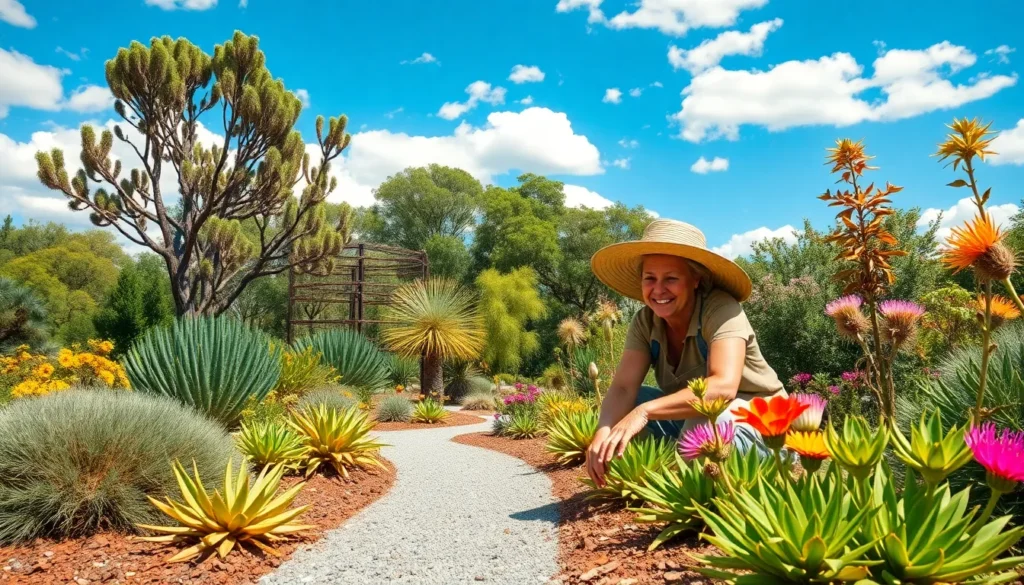Dreaming of transforming your outdoor space into something spectacular? We’ve discovered that Australian gardens offer unique opportunities that you won’t find anywhere else in the industry. With our diverse climate zones and stunning native plants we can create gardens that are both beautiful and perfectly suited to our local conditions.
Australian gardening isn’t just about following trends – it’s about working with our environment. From drought-tolerant native gardens in Perth to lush tropical paradises in Queensland we’ve learned that the best gardens celebrate what makes our continent special. Whether you’re dealing with sandy coastal soil or rich inland earth there’s a perfect garden style waiting for your space.
We’re here to show you exactly how to create your dream Australian garden. Our comprehensive guide covers everything from choosing the right plants for your climate zone to designing spaces that thrive year-round while keeping maintenance simple and water usage low.
Native Australian Plant Gardens That Thrive in Local Climates
Creating stunning native Australian plant gardens transforms your outdoor space while supporting local ecosystems. We’ll explore how to design gardens that flourish naturally in Australia’s diverse climate conditions using indigenous plants perfectly adapted to our unique environment.
Drought-Resistant Eucalyptus and Acacia Varieties
Eucalyptus trees create magnificent focal points with their distinctive bark patterns and aromatic foliage that requires minimal water once established. River Red Gums (Eucalyptus camaldulensis) thrive across most Australian regions, reaching heights of 20-35 meters while tolerating both drought and flooding conditions.
Acacia species offer versatility through over 900 native varieties ranging from shrubs to medium-sized trees. Golden Mimosa (Acacia baileyana) produces brilliant yellow flower clusters in winter and spring, requiring only 300-400mm of annual rainfall to flourish. Silver Wattle (Acacia dealbata) grows rapidly to 8-10 meters, creating natural windbreaks while attracting native birds and beneficial insects.
Combining different eucalyptus heights establishes natural garden layers that mimic Australian bushland ecosystems. Lemon-scented Gum (Corymbia citriodora) provides mid-story canopy coverage with its smooth white trunk and citrus-scented leaves that repel insects naturally.
Colorful Banksia and Grevillea Display Gardens
Banksia flowers deliver spectacular color displays throughout autumn and winter when most other plants remain dormant. Coastal Banksia (Banksia integrifolia) produces golden cylindrical flower spikes measuring 10-15cm long, attracting honeyeaters and lorikeets to your garden space.
Grevillea varieties provide year-round flowering with spider-like blooms in vibrant reds, oranges, pinks, and yellows that create stunning visual impact. Robyn Gordon Grevillea (Grevillea ‘Robyn Gordon’) flowers continuously, growing 1.5 meters tall and 2 meters wide while requiring minimal maintenance or supplemental watering.
Mass planting different banksia species creates dramatic seasonal displays with varying flower colors and sizes. Old Man Banksia (Banksia serrata) develops distinctive cone-shaped seed pods that add textural interest long after flowering finishes, while Firewood Banksia (Banksia menziesii) produces bright pink and yellow flowers from summer through winter.
Grouping grevilleas by flowering seasons ensures continuous color throughout the year while supporting native wildlife populations. Red clusters from Grevillea ‘Superb’ complement the orange tubular flowers of Grevillea juniperina, creating layered color schemes that change with seasonal progressions.
Ground Cover Options with Pigface and Saltbush
Pigface plants (Carpobrotus glaucescens) create dense carpets of succulent foliage topped with bright pink or purple daisy-like flowers from spring through autumn. These spreading perennials tolerate extreme drought, salt spray, and poor soils while growing 10-15cm high and spreading 1-2 meters wide.
Saltbush varieties (Atriplex species) establish excellent borders with their silvery-blue foliage that creates striking contrast against darker green plants. Old Man Saltbush (Atriplex nummularia) grows 1-3 meters tall, forming natural hedges that require pruning only once yearly while tolerating temperatures from -7°C to 50°C.
Combining pigface with native grasses develops textural contrast through different leaf shapes and growth patterns. Lomandra longifolia creates upright clumps of strappy leaves measuring 60-80cm tall, complementing the horizontal spread of pigface groundcover beneath established trees or shrubs.
Planting saltbush in groups of three or five creates informal clusters that appear naturally distributed across garden beds while providing habitat for small native animals and birds seeking shelter.
Water-Wise Garden Designs for Australian Conditions
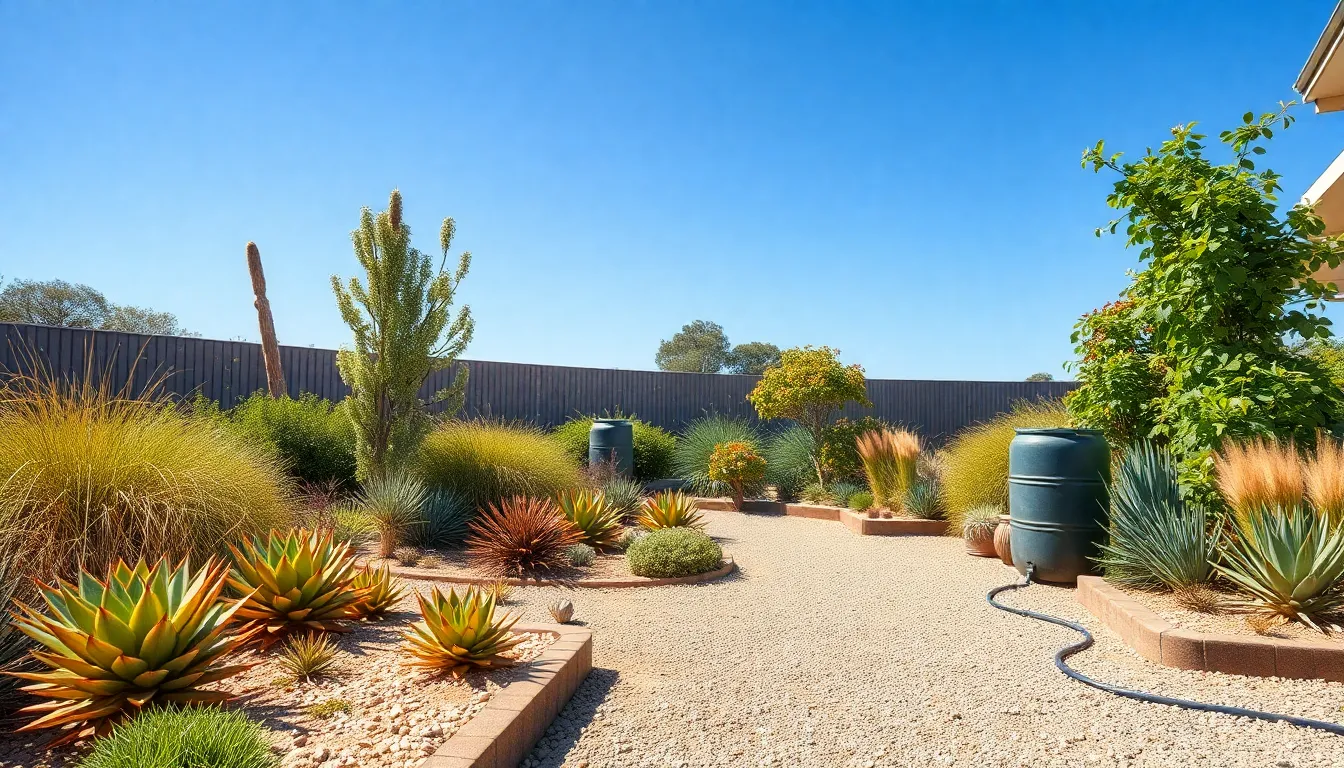
Smart water management transforms Australian gardens into thriving landscapes that flourish even though challenging climate conditions. We recommend selecting Western Australian native and drought tolerant plants that require minimal irrigation while providing maximum visual impact.
Xerophytic Plant Combinations for Minimal Irrigation
Succulents and cacti create stunning focal points when paired with native Australian species for water efficient garden designs. We group Echeveria with Agave americana to establish dramatic textural contrasts that require watering only once monthly during summer months. Native combinations work exceptionally well when we plant Stipa grasses alongside Eremophila species to create flowing movements that survive on rainfall alone.
Barrel cacti paired with native Grevillea shrubs produce year round interest while consuming 70% less water than traditional garden plantings. We position these xerophytic combinations in raised garden beds filled with sandy soil that drains quickly and prevents root rot during occasional heavy rainfall periods.
Gravel and Stone Mulching Techniques
Stone mulching reduces garden water requirements by up to 40% while creating visually appealing pathways between planted areas. We apply 3 inch layers of decomposed granite around drought tolerant plants to retain soil moisture and suppress weed establishment throughout growing seasons.
River rock mulching works particularly well around succulent gardens where we need excellent drainage combined with heat reflection properties. We choose light colored stones in coastal regions to prevent soil overheating and dark volcanic rock in cooler inland areas to absorb beneficial warmth during winter months.
Pea gravel creates attractive borders between different garden zones while allowing rainwater to penetrate slowly into surrounding soil. We install industry fabric beneath gravel applications to prevent mixing with underlying soil while maintaining proper water infiltration rates.
Rainwater Collection and Storage Systems
Rainwater harvesting systems capture up to 600 liters of water from every millimeter of rainfall on a 100 square meter roof surface. We install first flush diverters and leaf screens to ensure collected water remains clean and suitable for garden irrigation throughout dry periods.
Underground storage tanks connect directly to drip irrigation networks that deliver water precisely where plants need it most. We position these systems to gravity feed garden beds without requiring electric pumps that increase operational costs and maintenance requirements.
Above ground collection barrels work effectively for smaller gardens where we need 1000 to 2000 liters of storage capacity for seasonal watering needs. We integrate these systems into garden designs by surrounding them with climbing native vines like Hardenbergia violacea that provide natural screening while attracting beneficial wildlife.
Coastal Garden Ideas Perfect for Australian Seaside Homes
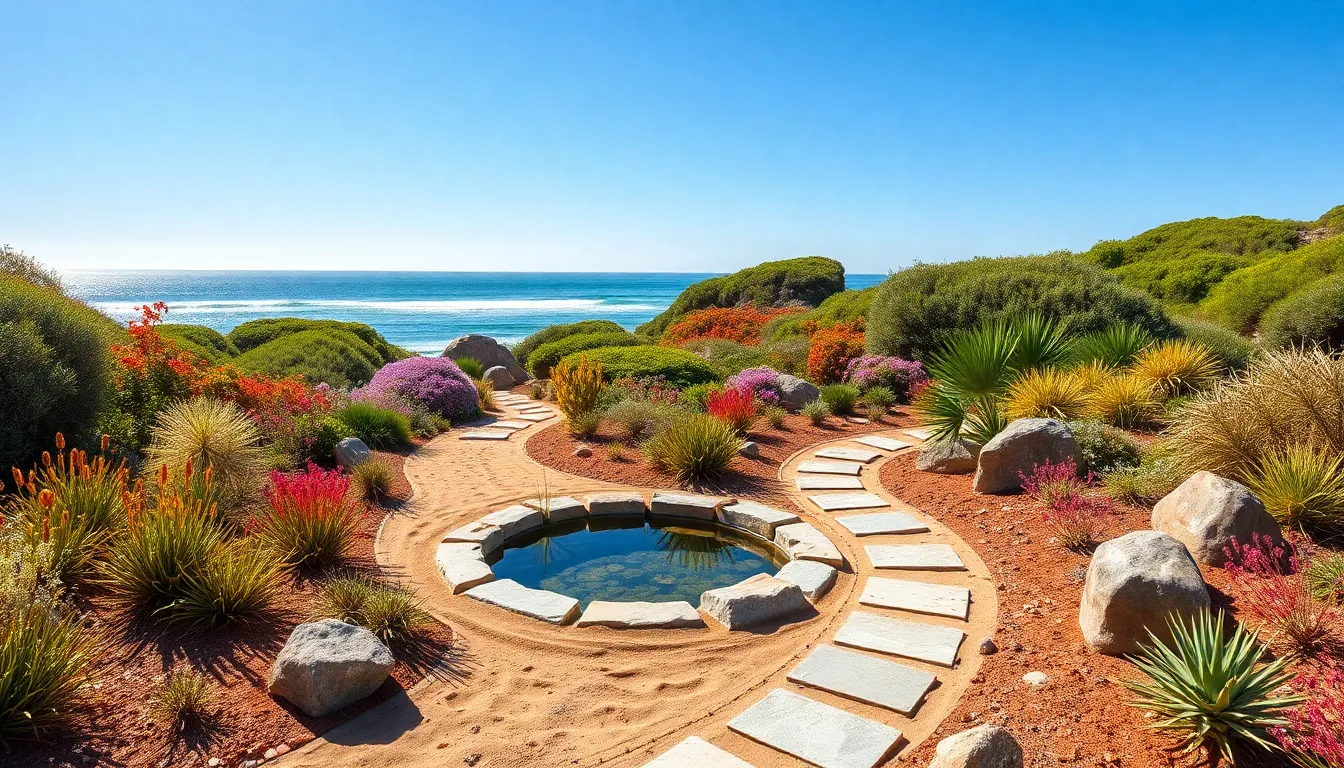
Creating stunning coastal gardens in Australia requires understanding how to work with salt spray, strong winds, and sandy soils while embracing the natural beauty of seaside living.
Salt-Tolerant Plant Selections
Banksia species form the backbone of successful Australian coastal gardens due to their exceptional robustness and natural ability to thrive in salt-laden environments. These native powerhouses create dramatic focal points while requiring minimal maintenance once established.
Grevillea varieties deliver vibrant flower displays throughout the year and adapt remarkably well to sandy coastal soils. Their nectar-rich blooms attract native birds and butterflies, adding movement and life to your seaside sanctuary.
Kangaroo Paw plants bring Western Australia’s iconic beauty to coastal gardens across the continent with their unique furry flowers and excellent salt tolerance. These striking perennials create stunning color contrasts against coastal backdrops.
Acacia species provide essential structural elements for gardens exposed to salt and wind, offering both screening and framework for more delicate plantings. Their quick growth and hardy nature make them perfect pioneer plants for new coastal developments.
Wind-Resistant Landscaping Strategies
Native plant communities naturally resist coastal winds while helping stabilize sandy soils through their deep root systems. Grouping plants in clusters mimics natural coastal vegetation patterns and creates more effective wind barriers.
Curved pathway designs reduce wind tunnel effects by creating gentle, flowing routes through the garden rather than straight channels that accelerate wind speeds. These organic shapes complement the natural coastal industry better than rigid geometric patterns.
Strategic placement of natural barriers using boulders, driftwood sculptures, or raised planting beds helps break up destructive wind patterns while adding visual interest. These elements create microclimates that protect more vulnerable plants from harsh coastal conditions.
Beach-Inspired Design Elements
Water features like ponds or fountains enhance the coastal ambiance by reflecting light and creating soothing sounds that complement nearby ocean waves. These elements work particularly well when integrated with native stone or recycled materials.
Mediterranean stone pathways add warmth and earthiness to coastal gardens while providing practical walkways that handle salt exposure better than traditional materials. Natural limestone or sandstone creates beautiful aging patterns over time.
Carpobrotus rossii ground cover delivers stunning white blooms while maintaining visual balance across large garden areas. This native succulent spreads naturally to create living carpets that require virtually no maintenance once established.
Tropical Garden Concepts for Northern Australian Regions
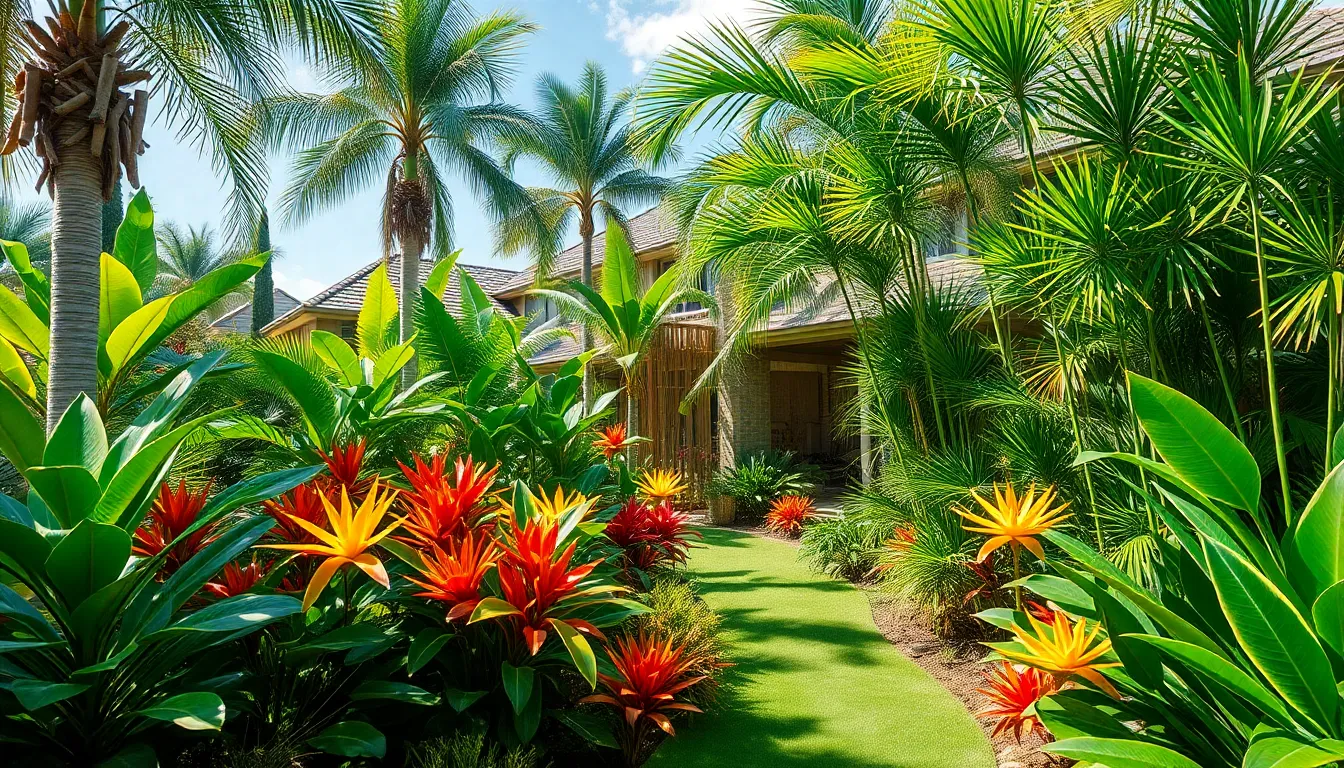
Northern Australia’s high humidity and warm temperatures create perfect conditions for spectacular tropical gardens. We can design stunning outdoor spaces that embrace the region’s unique climate while creating lush, vibrant landscapes.
Lush Foliage Plants for Humid Climates
Frangipani transforms any tropical garden with its fragrant white flowers and distinctive branching structure. This iconic plant thrives in humid conditions and requires minimal maintenance once established.
Cordyline adds dramatic color through its striking red or purple leaves that create stunning focal points. We recommend positioning these plants where their vibrant foliage can contrast against green backgrounds.
Heliconia produces brightly colored flowers that serve as natural showstoppers in tropical landscapes. These plants flourish in humid environments and attract local wildlife while providing year-round visual interest.
Combining these foliage plants creates layered textures that define authentic tropical garden aesthetics. We suggest mixing different leaf shapes and colors to achieve maximum visual impact throughout the growing season.
Palm Tree and Bamboo Features
Palm trees provide essential shade while establishing the classic tropical garden foundation that northern Australian climates support perfectly. These versatile plants create natural cooling zones and serve as stunning architectural elements.
Bamboo installations add vertical texture and height variation that transforms flat landscapes into ever-changing outdoor spaces. We use bamboo as natural privacy screens and windbreaks that complement palm tree plantings.
Tall palm varieties like coconut palms work exceptionally well as centerpiece plants that anchor entire garden designs. These specimens create dramatic silhouettes against the sky while providing practical benefits.
Strategic bamboo placement helps define garden zones and creates intimate spaces within larger tropical landscapes. We recommend using clumping bamboo varieties to prevent unwanted spreading throughout the garden.
Monsoon-Ready Drainage Answers
Rainwater harvesting systems collect and store the abundant rainfall that northern Australia receives during monsoon seasons. These systems provide sustainable irrigation answers that reduce water costs while supporting plant health.
Drainage channels direct excess water away from structures and plant root zones to prevent flooding damage. We design these channels to blend naturally with garden aesthetics while serving essential functional purposes.
Permeable pavers allow water infiltration through hardscape surfaces, reducing runoff and supporting natural groundwater recharge. These materials help manage heavy rainfall while maintaining attractive walkways and patios.
| Drainage Solution | Primary Function | Additional Benefit |
|---|---|---|
| Rainwater Harvesting | Water collection and storage | Reduces irrigation costs |
| Drainage Channels | Excess water removal | Prevents structural damage |
| Permeable Pavers | Water infiltration | Maintains aesthetic appeal |
Installing proper drainage before planting ensures tropical gardens remain healthy during intense monsoon periods that characterize northern Australian weather patterns.
Bush Garden Themes Celebrating Australian Wilderness
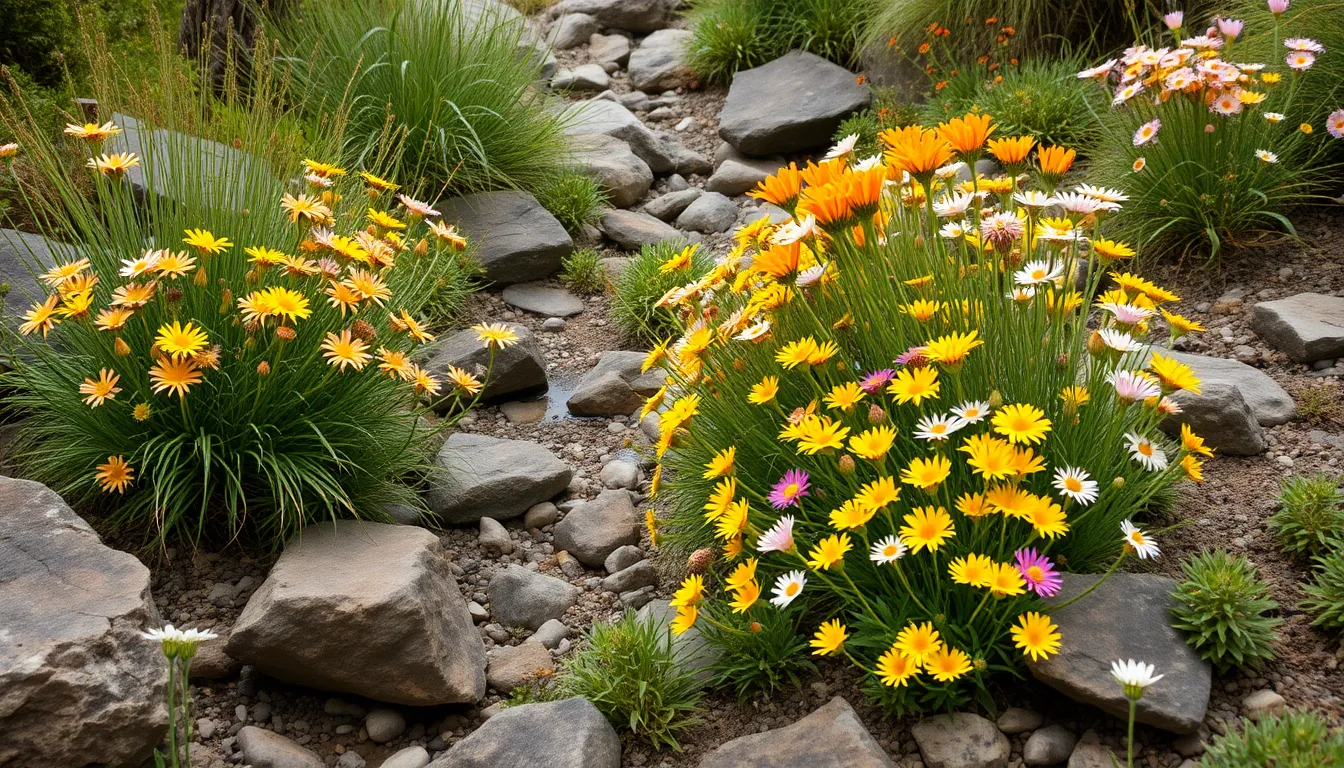
Australian bush gardens capture the raw beauty of our continent’s untamed landscapes. We’re recreating authentic wilderness environments that celebrate indigenous flora while supporting local ecosystems.
Native Wildflower Meadow Designs
Biodiversity becomes the cornerstone of native wildflower meadows that transform ordinary spaces into vibrant ecosystems. We plant diverse Australian wildflowers in naturalistic patterns that mimic wild meadows rather than formal garden beds. Species like Kangaroo Paw and native daisies create stunning displays while attracting essential pollinators to our gardens.
Design your meadow using clusters of complementary wildflowers that bloom at different times throughout the year. We achieve continuous color by combining early spring bloomers with summer and autumn flowering species. Strategic placement ensures each variety has optimal growing conditions while maintaining the natural, unstructured appearance of authentic bushland.
Maintenance requirements stay minimal when we select species suited to local soil and climate conditions. Native wildflowers establish deep root systems that access moisture and nutrients efficiently. We reduce watering needs by choosing drought tolerant varieties that thrive in Australian conditions without constant irrigation.
Rock Garden Arrangements with Indigenous Plants
Stone placement forms the foundation of authentic Australian rock gardens using local materials like sandstone and granite. We create natural looking arrangements by varying rock sizes and positioning them to mimic geological formations found in our bushland. Dry creek beds using rocks and gravel replicate natural water courses while providing excellent drainage.
Plant selection focuses on indigenous species that flourish in rocky, well drained environments. Cushion Bush and native grasses establish easily between rocks while providing textural contrast against stone surfaces. We incorporate drought resistant shrubs and succulents that naturally occur in rocky Australian landscapes.
Structural elements include gravel pathways that wind through planted areas and small water features that enhance the natural aesthetic. We position rocks strategically to create microclimates that shelter smaller plants while allowing larger specimens to showcase their architectural qualities. Layered planting heights add visual depth while maintaining the rugged bush garden character.
Wildlife-Friendly Habitat Creation
Habitat layers provide essential resources for native birds, insects, and small mammals throughout our garden spaces. We create canopy coverage using native trees, understory shrubs for nesting sites, and ground level plants that offer food sources. Strategic plant placement establishes corridors that allow wildlife movement between different garden zones.
Food sources include indigenous flowering plants that produce seeds, berries, and nectar throughout various seasons. Native shrubs and trees provide consistent nutrition while wildflowers attract insects that feed larger wildlife species. We avoid exotic invasive species that can disrupt natural food chains and compete with indigenous plants.
Water features enhance wildlife habitat through birdbaths, small ponds, and shallow drinking areas positioned at different heights. We incorporate natural materials like rocks and logs to create basking spots for reptiles and shelter for smaller creatures. Layered vegetation around water sources provides safety zones where wildlife can drink and bathe without exposure to predators.
Edible Garden Layouts Suited to Australian Growing Seasons
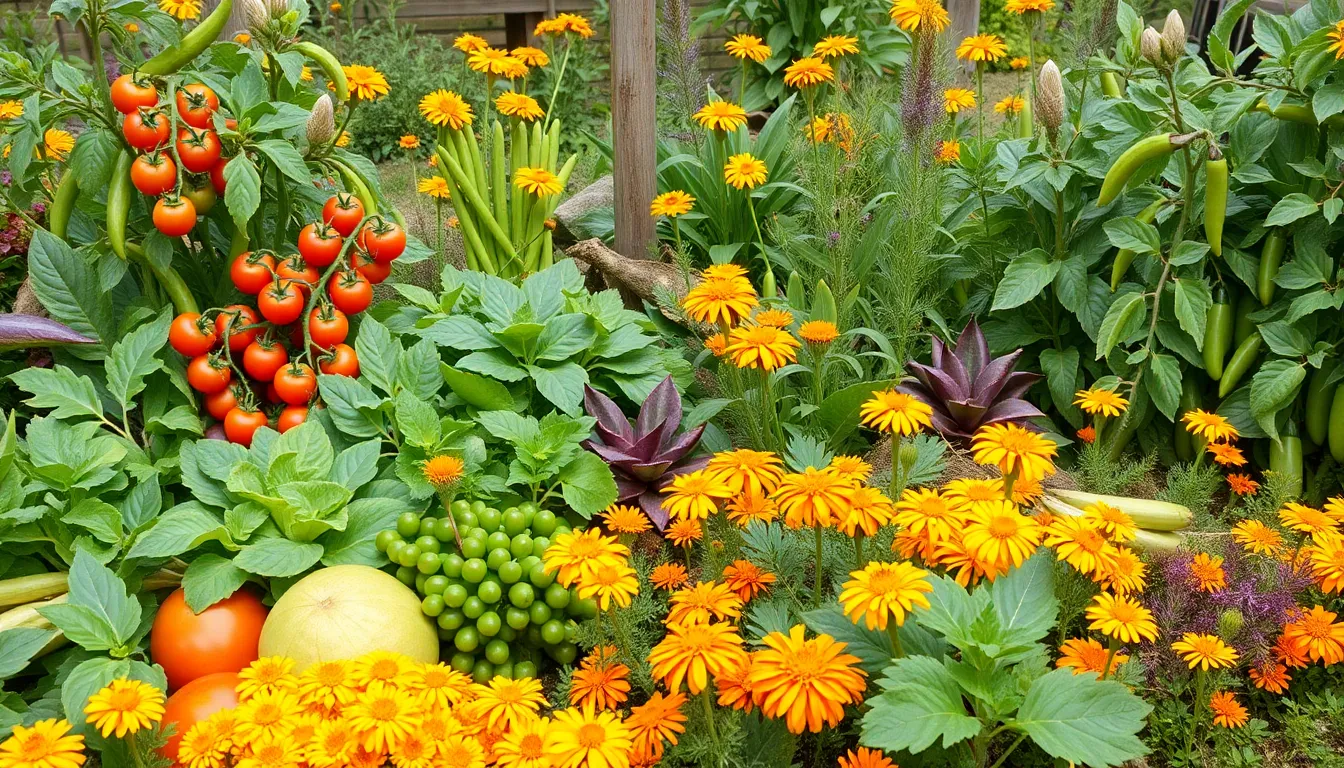
Australia’s dual growing seasons in spring and autumn create unique opportunities for designing productive edible gardens. We can maximize harvests by understanding these distinct planting windows and optimizing our garden layouts accordingly.
Year-Round Vegetable Growing Strategies
Spring brings ideal conditions for warm season crops like beans, broccoli, beetroot, capsicum, cucumber, eggplant, lettuce, onions, parsnip, potatoes, pumpkins, radishes, rhubarb, squash, sweet corn, sweet potatoes, tomatoes, and zucchini in temperate regions. We recommend succession planting lettuce every 2-3 weeks to maintain continuous harvests throughout both spring and autumn seasons.
Cool season varieties extend our growing calendar beyond traditional boundaries. Lettuce thrives in both spring and autumn plantings, providing fresh greens when other crops struggle with temperature extremes. We suggest selecting quick-maturing varieties to maintain steady production cycles throughout the year.
Autumn presents perfect conditions for cabbage and beans in temperate areas. The mild weather during this season supports a wider variety of vegetables than harsh summer months. We can plant cool season crops in late summer for autumn harvests, then transition to spring plantings for continuous food production.
Australian Native Food Plant Integration
Native food plants enhance our edible gardens while supporting local ecosystems and biodiversity. Kakadu plum delivers the industry’s highest vitamin C content, making it a valuable addition to any Australian food garden. We can integrate these powerhouse fruits into existing garden beds or dedicated native food zones.
Midyim berries provide sweet, blueberry-like flavors that thrive in Australian conditions without extensive care. These native berries adapt to various soil types and climate zones across the continent. We recommend planting them as understory plants beneath taller natives or as border plantings along garden edges.
Lemon myrtle offers aromatic leaves perfect for teas, cooking, and natural pest deterrence. This versatile native grows well in most Australian climates and requires minimal water once established. We can harvest leaves year-round for culinary use while enjoying the plant’s attractive white flowers and citrus fragrance.
Companion Planting for Pest Control
Basil repels aphids and whiteflies when planted alongside tomatoes, creating natural pest protection without chemical interventions. We plant basil throughout our tomato beds to maintain healthy plants while harvesting fresh herbs for cooking. This pairing also improves tomato flavor according to many experienced gardeners.
Marigold flowers deter nematodes that commonly attack tomatoes and carrots in Australian gardens. These bright annuals add color while protecting valuable crop plants from soil-dwelling pests. We scatter marigolds throughout vegetable beds to create protective barriers and attract beneficial insects.
Radish plantings help deter cucumber beetles through natural chemical compounds released by their roots and leaves. We interplant radishes with cucumber and squash family crops for dual benefits of pest control and quick-harvest root vegetables. Fast-growing radishes also help break up soil for companion plants with deeper root systems.
Small Space Garden Solutions for Urban Australian Homes
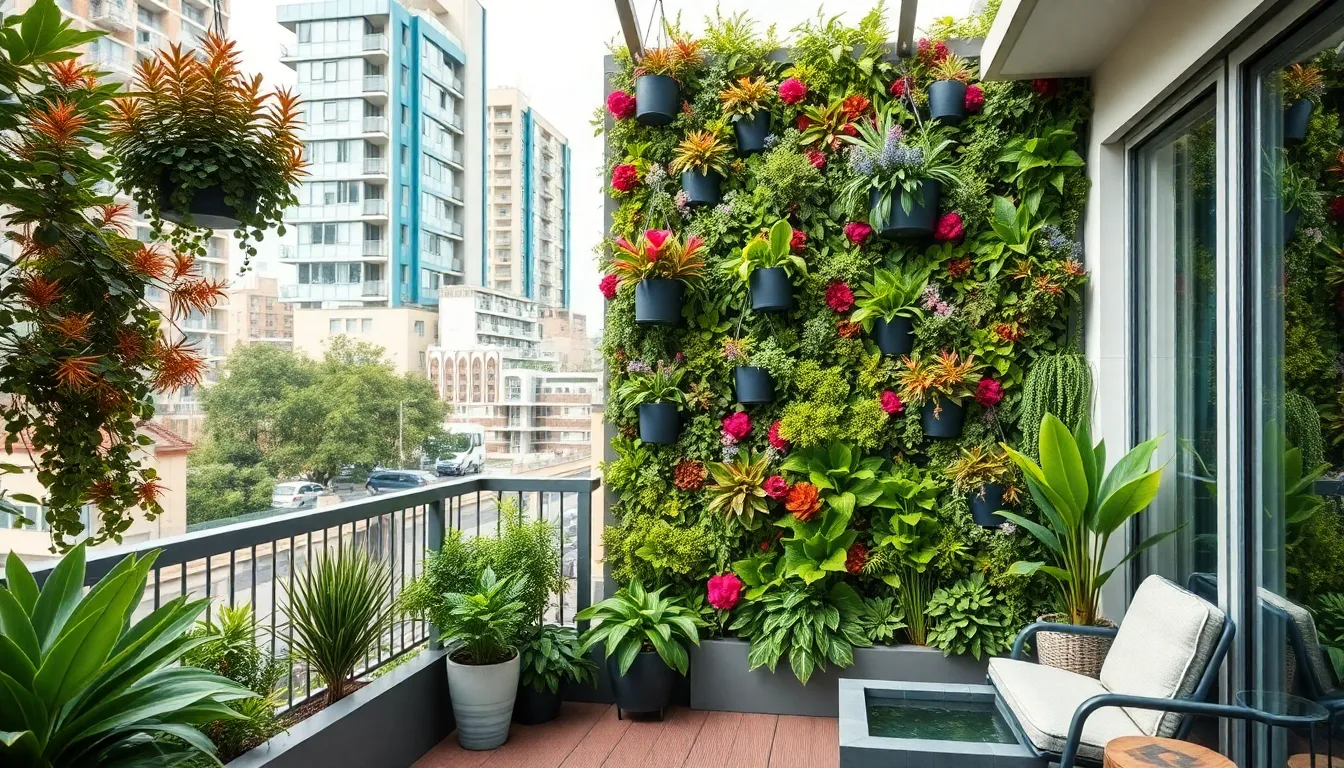
We’re transforming compact urban spaces into vibrant green sanctuaries that prove size doesn’t limit garden potential. Urban Australian homes can achieve stunning outdoor environments through strategic planning and creative design answers.
Vertical Garden Wall Systems
Vertical gardening maximizes green space by utilizing wall surfaces to create lush environments without consuming valuable ground area. We recommend installing modular wall systems that can accommodate various plant types while providing proper drainage and root support.
Hanging gardens transform bare walls into living art pieces that add both aesthetic appeal and functional growing space. Living wall planters mounted at different heights create visual layers that make small areas feel more expansive and ever-changing.
Green wall installations work exceptionally well on balcony railings, courtyard walls, and even indoor spaces with adequate lighting. We suggest combining different plant textures and growth patterns to achieve maximum visual impact while maintaining easy access for maintenance.
Container Gardening with Native Species
Container gardening offers unmatched flexibility for small spaces, allowing us to create moveable garden zones that adapt to seasonal changes and space requirements. Pots and planters enable precise control over soil conditions and plant placement.
Native species like Banksia, Grevillea, and Callistemon thrive in container environments while requiring minimal maintenance and water. These hardy plants provide habitat for local wildlife and deliver stunning visual displays throughout different seasons.
Strategic container placement creates defined garden areas that maximize both functionality and beauty. We arrange different sized pots to establish natural flow patterns while ensuring each plant receives optimal growing conditions.
Native plant combinations reduce maintenance requirements significantly compared to exotic species, making them perfect for busy urban lifestyles. Indigenous varieties adapt naturally to local climate conditions and support beneficial insects and birds.
Balcony and Courtyard Optimization
Built-in seating maximizes ground space efficiency while providing comfortable areas for relaxation and entertaining. We integrate storage answers beneath seating to house garden tools and seasonal decorations.
Small water features enhance ambiance with soothing sounds while attracting beneficial wildlife like birds and butterflies to urban gardens. Compact fountains or water bowls create focal points without overwhelming limited space.
Strategic mirror placement amplifies existing greenery and creates illusions of expanded space through reflected plant imagery. We position mirrors to capture and reflect the most attractive garden angles while avoiding direct sunlight that might damage plants.
Combining different foliage textures and colors creates visual depth that makes compact areas feel significantly larger than their actual dimensions. We layer plants with varying heights and leaf patterns to establish natural progression from ground level to vertical elements.
Fire-Resistant Landscaping Ideas for Australian Properties
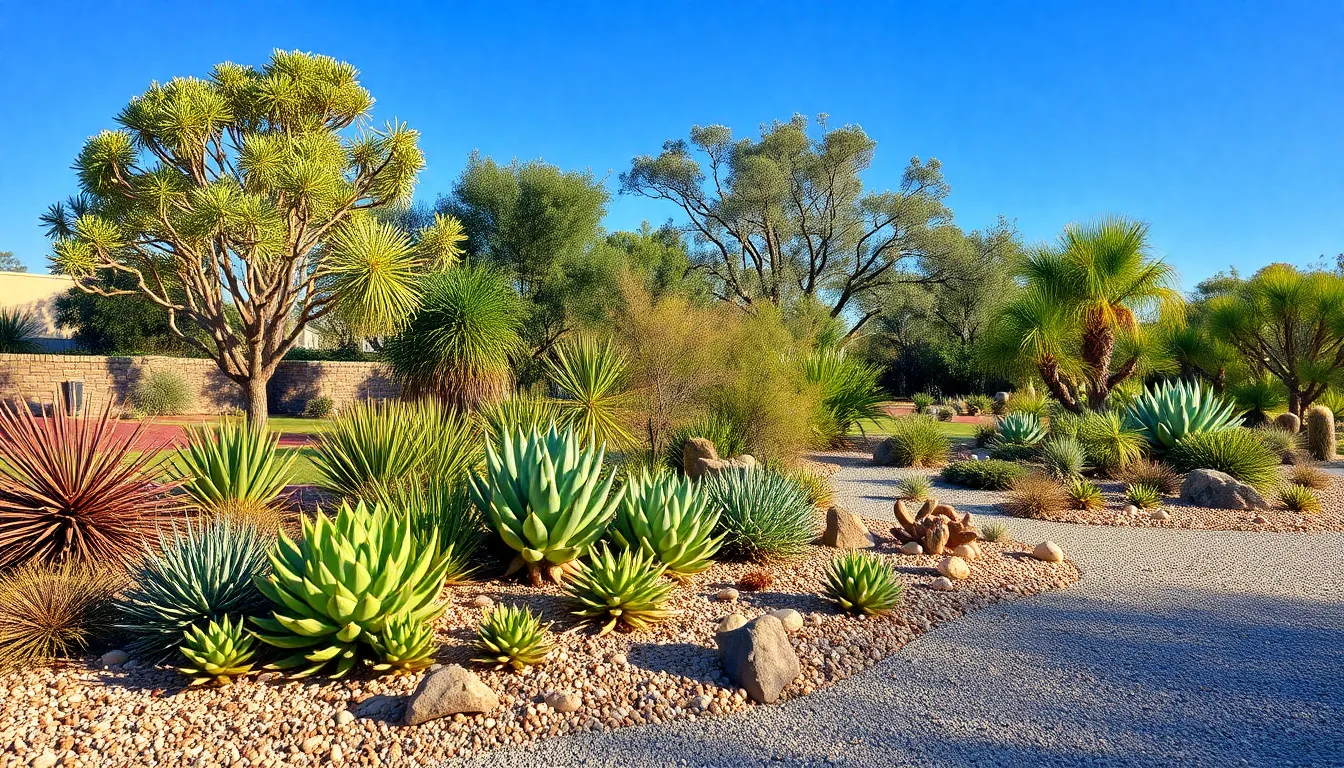
Creating fire-resistant landscapes becomes essential when we consider Australia’s bushfire-prone environment. Our strategic approach to plant selection and garden design can significantly reduce fire risk while maintaining beautiful outdoor spaces.
Strategic Plant Placement for Bushfire Protection
Selecting low flammability plants forms the foundation of bushfire-resistant landscaping across Australian properties. Succulents like agaves and sedums naturally resist fire due to their high moisture content and fleshy leaves that don’t ignite easily. Deciduous trees such as Japanese maples and smoke bushes offer excellent protection since they shed leaves during dry seasons, eliminating potential fire fuel from our garden spaces.
Island planting techniques create natural firebreaks by arranging vegetation in separated clusters surrounded by non-combustible materials. We recommend spacing plant groupings at least 10 feet apart and surrounding them with gravel pathways or mown lawn areas. This strategic arrangement prevents flames from jumping between vegetation patches and gives firefighters better access during emergencies.
Layered vegetation placement helps us control fire intensity by positioning different plant heights strategically throughout our industry. Ground covers stay closest to structures, followed by shrubs at medium distances, and tall trees positioned furthest from buildings to create graduated fire protection zones.
Low-Flammability Ground Cover Options
Non-combustible ground materials provide the most effective fire protection while improving our garden’s visual appeal. Gravel pathways, decorative rocks, and stone mulches create natural firebreaks that stop flame spread and require minimal maintenance throughout Australia’s harsh seasons.
High moisture content plants serve as living firebreaks when we incorporate species that retain water in their tissues. Succulents including jade plants, aloe varieties, and native pigface maintain moisture levels even during drought conditions, making them virtually fire-proof ground cover options.
Decomposed granite surfaces offer an attractive alternative to traditional mulches while providing excellent fire resistance. We can combine decomposed granite with drought-tolerant native grasses to create textured landscapes that remain green with minimal irrigation.
Defensible Space Garden Design
Creating defendable zones around our homes requires maintaining clear separations between combustible vegetation and structures. We should establish a minimum 30-foot defensible space where flammable materials like wooden fences, sheds with combustible contents, and dense plantings are eliminated or relocated.
Material selection strategies focus on using fire-resistant hardscaping elements near our homes including stone retaining walls, concrete pathways, and metal garden structures. These materials won’t ignite during bushfires and can actually help protect surrounding areas from radiant heat.
Regular maintenance schedules keep our fire-resistant landscapes effective by removing dead plant material, pruning overhanging branches, and clearing gutters of leaf debris. We recommend monthly inspections during fire season and quarterly deep cleaning to maintain optimal protection levels throughout the year.
Seasonal Color Gardens Adapted to Australian Climate Zones

Creating year round visual appeal in Australian gardens requires understanding how seasonal changes affect plant performance across different climate zones. We’ll explore strategic planting approaches that deliver continuous color while working harmoniously with Australia’s diverse seasonal patterns.
Spring Wildflower Displays
Spring wildflower gardens transform Australian landscapes into spectacular color showcases using indigenous species perfectly adapted to local conditions. Kangaroo paw creates striking orange and red displays while thriving in cooler spring temperatures across Mediterranean climate zones. Waratah produces brilliant crimson blooms that serve as dramatic focal points in temperate regions during September and October.
Banksia species offer golden cylindrical flowers that attract native birds and provide long lasting color from August through November. We recommend combining these native wildflowers with complementary species like Sturt’s desert pea and pink rock orchid to create layered displays. These combinations work exceptionally well in areas with winter rainfall patterns where spring moisture supports vigorous flowering.
Mass plantings of native wildflowers create the most dramatic visual impact while requiring minimal irrigation once established. Planning wildflower displays around natural rainfall patterns ensures sustainable growth and reduces maintenance requirements throughout the flowering season.
Summer Heat-Tolerant Blooms
Summer gardens demand drought tolerant plants that maintain vibrant displays during extreme heat and extended dry periods. Succulents like Echeveria and Agave americana create sculptural interest while producing colorful flower spikes that thrive in temperatures exceeding 40°C. Cacti species including prickly pear and barrel cactus offer unique architectural forms with brilliant yellow and pink blooms.
Westringia fruticosa delivers consistent white flowers throughout summer months while requiring minimal water once established. Casuarina ‘Green Wave’ provides textural contrast with its needle like foliage and ability to withstand prolonged drought conditions. These selections work particularly well in Mediterranean climate zones where summer rainfall is scarce.
Combining different plant heights creates visual depth while ensuring adequate air circulation between specimens. Strategic placement of heat tolerant bloomers near reflective surfaces like light colored walls maximizes their cooling benefits for surrounding plantings.
Autumn and Winter Interest Plants
Autumn and winter gardens maintain visual appeal through strategic selection of plants that offer persistent foliage, structural form, and seasonal flowering. Ornamental grasses like Stipa species provide movement and texture while developing attractive seed heads that persist through winter months. Camellia varieties produce spectacular blooms from May through August when most other plants remain dormant.
Liquidambar trees create stunning autumn color displays with their changing foliage before dropping leaves to reveal attractive winter branching patterns. Native bottlebrush species offer winter flowering that provides nectar for birds while adding bright red accents to dormant landscapes. These plants work effectively across temperate and subtropical climate zones.
Evergreen shrubs with interesting bark textures or unusual growth habits maintain garden structure during cooler months. Positioning winter interest plants near frequently used pathways and viewing areas ensures their seasonal beauty receives maximum appreciation throughout the year.
Conclusion
Creating the perfect Australian garden means embracing our unique environment and working with nature rather than against it. We’ve shown you how to harness native plants drought-resistant designs and seasonal planning to build outdoor spaces that thrive in our challenging climate.
Whether you’re dealing with coastal salt spray tropical humidity or bushfire risks there’s a garden solution that’ll work for your exact conditions. From small urban balconies to expansive rural properties these ideas help you create sustainable beautiful spaces that support local wildlife while reducing maintenance.
The key to successful Australian gardening lies in understanding your local climate zone selecting appropriate native species and implementing water-wise practices. With these strategies you’ll develop a garden that’s not only stunning but also perfectly suited to our diverse industry.
Frequently Asked Questions
What makes Australian gardening different from other countries?
Australian gardening focuses on working with the environment rather than against it. The country’s diverse climate zones require different approaches, from drought-tolerant gardens in arid regions to tropical landscapes in the north. Success comes from choosing native plants that naturally thrive in local conditions, conserving water, and supporting native wildlife ecosystems.
Which native Australian plants are best for drought-resistant gardens?
Eucalyptus and Acacia species are excellent choices for water-wise gardens, requiring minimal irrigation once established. Banksia and Grevillea provide stunning color displays while attracting native birds. For ground cover, Pigface and Saltbush create beautiful texture and are extremely resilient to dry conditions.
How can I create a water-wise garden design in Australia?
Combine native drought-tolerant plants with succulents and cacti for maximum water efficiency. Use gravel and stone mulching to reduce water requirements and enhance aesthetics. Install rainwater collection systems with underground tanks or above-ground barrels. Group plants with similar water needs together for efficient irrigation.
What plants work best for Australian coastal gardens?
Salt-tolerant plants like Banksia, Grevillea, and Kangaroo Paw thrive in coastal environments with salt spray and sandy soils. These plants also attract local wildlife. Use wind-resistant landscaping by grouping plants naturally and incorporating curved pathways to reduce wind tunnel effects while creating beach-inspired design elements.
How do I design a tropical garden in northern Australia?
Focus on plants that love humidity and warmth, such as Frangipani, Cordyline, and Heliconia. Use palm trees and bamboo for shade and vertical texture. Ensure proper drainage solutions for monsoon seasons with rainwater harvesting systems, drainage channels, and permeable pavers to manage heavy rainfall effectively.
Can I create an edible garden that works with Australia’s climate?
Yes, by utilizing Australia’s dual growing seasons in spring and autumn. Practice succession planting and grow cool-season crops year-round. Incorporate native food plants like Kakadu plum, Midyim berries, and Lemon myrtle. Use companion planting techniques with basil, tomatoes, marigolds, and carrots for natural pest control.
What are the best solutions for small urban Australian gardens?
Maximize vertical space with wall garden systems and use container gardening with native species for flexibility. Optimize balconies and courtyards with built-in seating, small water features, and strategic mirror placement. Choose compact native plants that provide maximum impact in minimal space while requiring low maintenance.
How can I make my Australian garden fire-resistant?
Select low flammability plants like succulents and deciduous trees. Create defensible space around your home using fire-resistant materials. Implement island planting techniques to create natural firebreaks and use layered vegetation placement to control fire intensity. Regular maintenance and strategic plant placement are essential for bushfire safety.
Which plants provide year-round color in Australian gardens?
For spring, choose native wildflowers like Kangaroo Paw and Waratah. Summer heat-tolerant options include Echeveria and Westringia fruticosa. For autumn and winter interest, plant ornamental grasses and Camellia varieties. Understanding your local climate zone helps ensure continuous seasonal color displays throughout the year.

